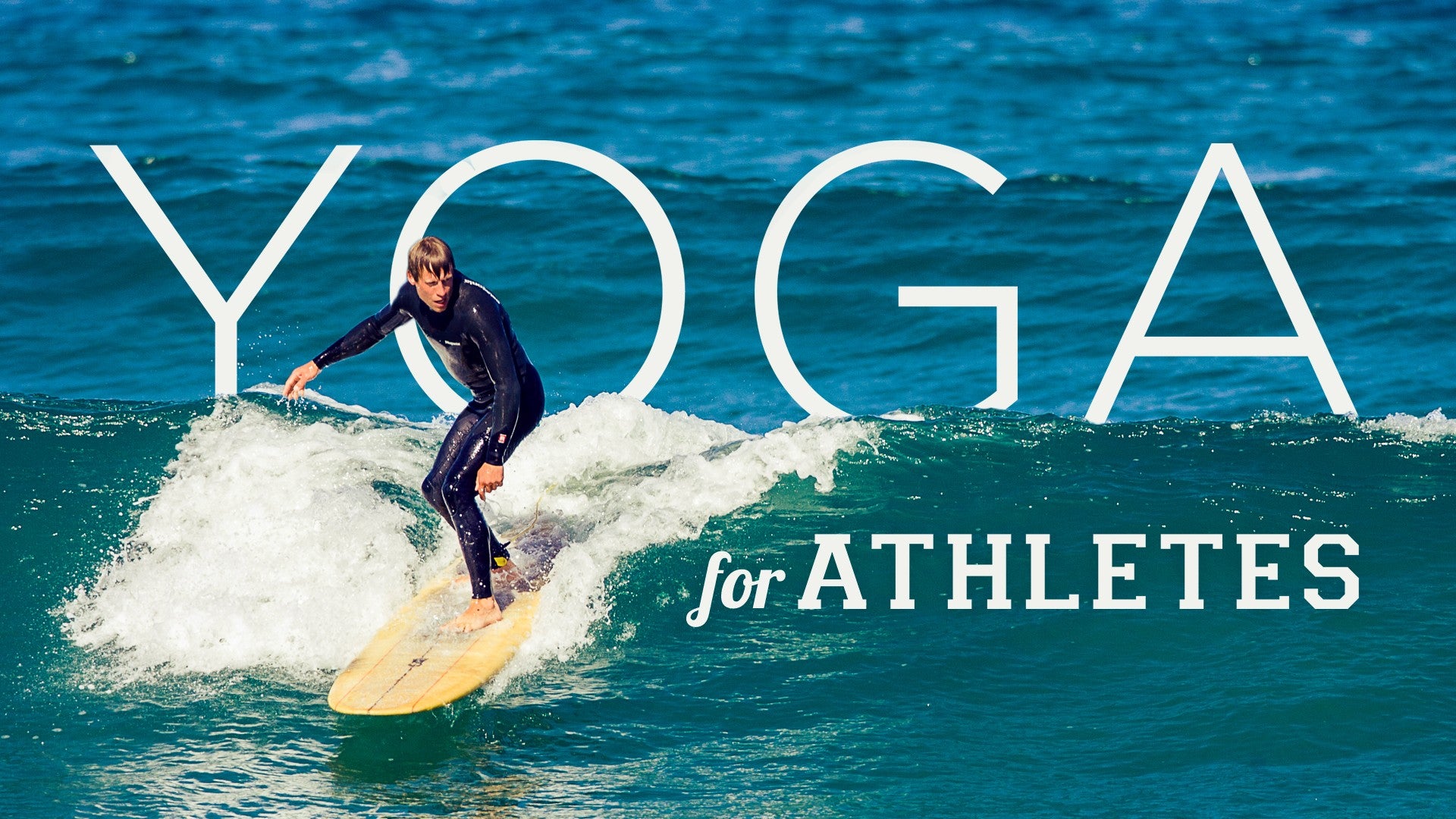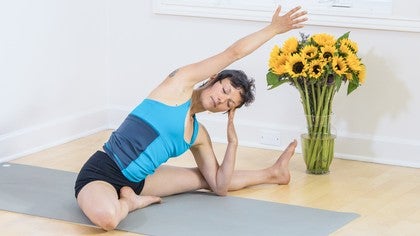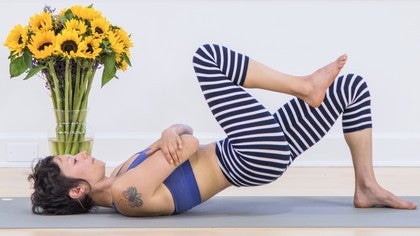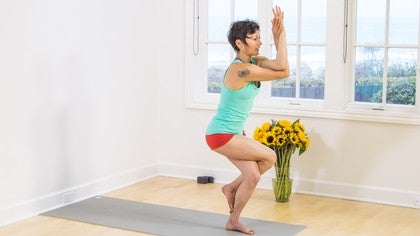Description
About This Video
Transcript
Read Full Transcript
(rushing waves) Hi. This is a short yoga sequence for bikers. And I want to thank Scott Everett, my friend Scotty Everett for helping me a ton with learning about different areas where bikers might hold a lot of tension. And what I've heard from him and a few other people, lower back, lot of tension there. Front of the chest, obviously quads and glutes, hamstrings.
And the neck was a huge thing that came up. So, especially in road cycling, maybe where the position of the handlebars is a bit lower, and then the neck is thrust forward. So that, as my friend Scotty said, "If your C4 and C5 "have unknowingly become really close friends." Maybe not such a good thing. So we're gonna get into some neck traction stuff. So if you're not a biker, and all that stuff sound like it relates to you, you should join us.
So let's come on to the back to start. Oh, and I should mention that if you have a block at home, it could be useful in the sequence, but you don't need it. So if you don't have it, it's no big deal. So let's come onto the back, just wide in the feet. And allow for the legs to fall to one side, and then into the center and over to the other side.
We like to call this windshield wipers. So there's a massage at the back of the pelvis. Maybe a nice release into the back. And then let's let the legs come into the center. Straighten out the legs.
And draw the right knee in towards the chest. And you can either hold on under the hamstring or on top of the shin, depending on where the clasp feels more comfortable. And draw that knee in towards you, as you stretch out through the opposite heel. So this is a multitasking position where you're also getting a nice stretch through your hip flexor, as well as getting a nice hip flexion through your other leg. And then let's take our left hand across to the outside of the right knee and kinda of start to draw that across the body.
Take your right arm out to the side, and exhale and just find a little twist here. So inhale into the center, you could even kind of place your right foot on your thigh, exhale across the center. Inhale back into neutral. And just a couple of times. So you're getting into that, all that lumbodorsal fascia in this nice twist.
All that stickiness in the low and middle back. And then come into the center. Release that leg. Take a couple breaths. You might notice that if you just do the movement without breathing, it's usually not as effective.
Or you might not relax into it as much. So draw your left knee into your chest, hug it in. Stretch out through your opposite heel. And see if you can bring your lower back a little closer to the floor. Like not rounding it, but just dropping it down.
Take your right arm across left arm out to the side and start to come into just as much twist as feels like it's warming up. And you might see that my right leg is kind of tipping over to the side when I do this, which is fine. Just allow it to happen. Thinking about all those layers in your back just peeling apart. And then release.
Couple of breaths. So we're gonna roll over onto one side. And come up onto our hands and our knees. And we're gonna sit back on our heels, take our elbows forwards. Let the hands come together.
Draw the front ribs into the body, and towards the pelvis, and let the head come down. And you can play with allowing the arms to slide forwards and back. And you might stay in this back position for a couple breaths. Breathing big breaths into the lower back. And then let's just come up a little bit here so that you can grab ahold of your jaw.
With the heels of your hands. And... Tuck your chin, move your elbows back until it feels comfortable. Tuck your chin and then move your hands, it's like you're pulling your skull away from your seat. So tuck your chin in.
Slide some space in between those upper cervical vertebrae by pressing this way. That feels really good. So if you want to, you can actually move your chin forwards and pull. Which it might feel good for some people to have that cervical curve there, or for some people, it might feel good to tuck the chin a bit and pull. And feel how your neck goes all the way into your mid back.
And release that. And we're gonna come all the way up to standing for a standing sequence. So you can press through downward dog, slowly start to open up the back of the legs, maybe paddle the feet a little bit. And make your way towards the top of the mat. Feet hip distance, take your hands on your shins.
Find your long spine, soften your knees, fold forwards. A really nice neck release in this forward fold, as you're breathing and letting the backs of the legs start to open, is just hang your head. And just rotate to look over towards your right. And then use as little, sort of muscle as you can. And rotate to look over to the left.
You might find one side a lot more stiff. Bend your knees here, exhale, find your feet. Press your feet a little bit into the earth, suck your belly back towards your spine, and roll up. One vertebrae at a time. Head is the last thing to come up, and just give your shoulders a little bit of a roll here.
Standing at the top of the mat. And inhale your arms up. Stabilize your lower back and maybe take a little bit of a back bend into your, just your top three ribs. And then exhale and fold forwards. Inhale and lengthen the skull forwards, take your right foot back, into a high lunge.
Exhale, drop the knee down. Inhale, come up, and see if you can form a straight line from your knee to your shoulders. So instead of sinking forwards, you're actually shifting back. Take your arms up, and tailbone sinking towards the earth. Exhale.
Hands on the floor. Pick up your back knee. Inhale, walk all the way around, and sort of turn your feet so that all of your toes point out to the right, so walk all the way around. Hands under the shoulders, maybe your fingertips or your hands flat. Bend your knees until you can feel that you're not clamping down in the back of the legs.
So there's a bit of a feeling of easing into this. Maybe for some people, it's fine to straighten the legs. Pressing into all of your toes and the full, the full heel. And then let's walk our hand forwards. Press your fingertip into the floor and of you have sticky shoulders, you can actually turn your hands out to the sides.
And then sink your hips back, and lift your armpits and sink your spine down into your body. And then walk back here. Turn one foot out, and turn the knee out with that foot. And then sink into that side, walk your hands over to the side, and as you press into the whole sole of your left foot, you're pulling a long line up into your pelvis, so you're getting a really nice stretch in your adductors. So one time over to the side.
Switch, make sure your knee is somewhat over your ankle. So you don't need to turn out so much with your foot, and then turn your knee in. Not so healthy for the knee joint. Let's come over to the other side again. And this time, place your hand on your ankle.
And you can even use your elbow into your knee to pressurize a little bit of opening into that inner thigh. And then over to the other side. Super nice, so walk back into the center. Maybe bring your legs a little closer together. And fold forwards.
So either here, place your hands just on the back of your skull for a neck traction, and with the weight of your elbows and forearms, drop down. And just because I'm flexible, I actually have to come a little bit closer together to really have my head off the floor, but you might still stay wide. If you want a bit more neck traction, interlock your hands behind the base of your skull, so that you're kind of catching your jawline with your forearms. And with the weight of your arms, drag down a little bit. And this is quite a deep decompression for the neck.
Also a nice opening for the hamstrings. So then we're going to walk all the way back around to the shape of this lunge. And step back into downward-facing dog. From downward-facing dog, inhale into the plank pose. And exhale down onto the belly.
Take your chin to the floor, and see if it's okay. If it's too much, place your forehead on the floor. But I like the feeling of taking my chin to the floor, so I'll do that. Take one hand over the other on your lower back. So what you want to feel here is that your lower back is, you're not really using your lower back, so hug your belly muscles.
Like, ice cream scoop your belly back towards your spine. And with your hands here on your lower back, try not to use the lower back muscles. Inhale, lift, just a little bit, the heart and the legs. And then exhale, come down. So we're gonna do this five times, this is really stabilizing your lower spine.
And bring your shoulder blades onto your back. So lower tips of the shoulder blades down. Two. So inhale to come up. And exhale to come down, three.
Inhale to come up. If this is cranking your neck at all, look down. Exhale to come down, see if you can feel smoothness in your back muscles and not ropy tension around your spine. Belly is lifting away from the floor if you can. There's a vacuum at the back of your belly, lifting your belly towards the back.
Exhale to come down, really good. Hands by the ribs. Press back into downward dog. So right foot forward, so we'll do the sequence on the other side. You may need to up forwards.
Exhale, left knee and the top of the foot down. Inhale, come up, and see if you can find a straightish line from your knees all the way to your shoulders. And almost feel like your tailbone's dropping down to the floor. So you should feel that opening in your hip flexors. Take your arms up.
Exhale, come back into tucking the toes and lifting the back knee off the floor. And then turn your toes to the left to walk all the way around to the back of the mat. Couple breaths here, just to open up through the backs of the legs. You might need to bend. Start to straighten if it's okay.
Walk your hands way forwards. Press your fingertips down, lift your armpits up, and allow for a nice stretch in the feeling of your arms being over your head. Don't lock your elbows, but straighten them so that you can feel from your fingers all the way into your hips. It's like someone's pulling your hips back here. Walk back your hands underneath your shoulders, and start to walk over to one side.
Turn the foot out, turn the knee out, and sink into that side and see if you can plant even the pinkie toe side of your opposite foot. Inhale into the center. And you can almost come up onto your heels here and just do a shift. Pinkie toe side of the foot grounds. Over to the side.
This time, place your hand on your ankle and even use your elbow to push the knee back. Really nice in the hip, it's almost like you can also use your glute muscle, supporting with the glute muscle to hug the hip into the body. And over to the other side. Inhale into the center. Walk all the way around to the front.
Downward dog. Plank pose. All the way down onto the belly, elbows in. Chin or forehead to the floor. You can put your hands on your lower belly and just see if you can feel as you exhale, draw your lower belly back towards your spine.
Almost balloon or puff up your lower back a little bit. And then inhale, and lift legs and chest. One, exhale, come down. I really like this feeling of putting your hands on your back. Two, come up and down, because you can feel if those back muscles are working.
Or if you can really hug belly muscles back to the spine, and neutralize your lower back. Bring your shoulder blades down your back. Three. This feels great, and four. Sometimes people think they need to forward fold a lot to undo back tension, but actually, they might need to stabilize.
Five. Who knows? Step back into downward-facing dog. You can bend your knees if you wanna get into those hamstrings. Find the sit bones rising as you drop the heels.
Maybe do that a few times. Just to slide though the muscle tissue. Step the feet forwards towards the top of the mat. Inhale. And exhale, fold.
Inhale, come all the way up. And exhale. So you might need your block for this sequence. I'm just gonna have it beside me in case. If you have a block.
So let's inhale the arms up, exhale, fold forwards. Find your block or the floor. Let your right leg come up and back behind you. And then let's start with the hips equi-distance from the floor. So the two frontal hip bones pointing down towards the floor.
You could lift your leg and externally rotate it, but you're not really getting into the area that we want to when you do that. So. You're already... Maybe a little bit stickier in the front of the hips from biking, than you would be in the back of the hips, so this movement is not getting into the inner thighs as well as we'd like to in the hip flexors. So see if you can lift that leg as much as you can back behind you with the big toe pointing down, and an internal rotation in the leg.
So some people would be here. Couple breaths. Drive your heel and your toes into the earth. Of the standing leg. You could even try kind of lifting and lowering this back leg a little bit, see if you can get a little bit more length, sliding that leg out of the pelvis and up.
Then let's take it back behind the other leg. Bending the knees if you need to, you might also want this. And press into the inner edges of your feet. So your big toes and your inner heels. And then see of you can fold, and this is a really nice one for your IT bands.
And the outer hips. You might notice here too, that your lower belly is hardening to do this, and you're kind of shortening and rounding your spine. If that's happening, that's why the block is nice. Lengthen and release your lower belly, which makes it much more intense. And then fold with that length and release in your lower spine.
So the fingertips to the ground, we're actually gonna walk them back a bit. Take that back leg, and either take the knee on the inside of the foot to sit down, or if you can manage, on the outside of the foot to sit down. But both sit bones should be fairly level. So you could be like this, or like this. If you're not level, you can sit on something.
Or a blanket. This is obviously again, getting into the IT band, which you'll feel. So hug across with your right arm. Take your left hand behind you. Lift.
As you ground through your seat, left your spine up. Relax your shoulders. And spiral around. Nice. So we're gonna unwind a bit here.
And. Open our left leg out. You'll see this when I do it on the other side a bit better, but open it up into this position. So we're opening up into this position. Heels pressed together, take your fingertips behind you, and see if you can kind of neutralize your back, so your back muscles are quiet, they're not working hard.
They're not extending, they're not flexing. So your lower belly's not flexing, you have a neutral spine. If you wanna make this deeper, and you have a block, place it in between your inner feet. Your knees might be way up like this, but it'll get a lot more into your adductors and your thighs. Okay.
So we're going to unwind our right leg, place the inner leg on the floor. Walk around just in a little twist. Hug the belly back towards the spine with the breath. (deep inhale) Then we'll unwind all the way to the front. Forward fold.
Other side, so inhale, come on up. Exhale. Inhale. Exhale. Block or floor.
Inhale, left leg up. And then this one also, it's easy to use your lower back muscles to lift that leg, but a little hard still to balloon open the lower back. Neutralize it, keep it soft. I mean, don't obliterate the curve, but open it up. And then see if you can lift the back leg up a little bit higher, maybe in little pulses.
Without really doing anything with your back muscles. Maybe you fold forwards a little bit more. Internally rotate that leg so you can really get into the hip flexor area, and then also, yes, this outer hip. Take it behind. Plant the inner parts of the feet.
Root down and come into these lateral lines of the leg. Maybe here, especially if you need that feeling of lengthening the lower belly instead of flexing it. Then fold forwards. Bending the knees here might be the only way to do it without really getting too much pulling on the outer knee. Okay so let's come down.
So again, knee comes on the inner, or the outer. But both sit bones grounded. Come across, right fingers come across. Take a deep breath, and as you exhale, just drop your hips. And then stretch your spine out of your pelvis.
It might not be visible to the outer eye but you can feel it. And then spiral around. So if the vertebrae are jammed together, there's not very much place for twisting, but if there's some space, there's all this space for moving them. So you just imagine that inside your body. And then we're gonna come out.
Love that one, lord of the fishes pose. Open up through the inner thighs. Spicier option. Fingertips behind, because this might be the back shape, so bring it into a bit more neutral. Or the inner feet come together.
Of course, you could fold forwards in this one. If you'd like to fold forwards, just make sure it feels like someone's pushing your sacrum into your body. And then, you can fold forwards, and keep the back muscles as quiet as possible. And by quiet, I mean like, not overworking. Come on up.
Bring this inner leg to the floor. Find this twist. And as you exhale, ice cream scoop the belly back towards the spine. So you have that support through the back of the pelvis. And unwind.
So let's get into the pectoral area a little bit. Hands back behind you, feet forwards. You can check in if want your hands to point back or point them forwards like this. I like this option, but it's also maybe a little bit more intense for some people's shoulders. Because turning them in actually works the smaller muscles, the deeper muscles.
Like the pec minor. This way is a bit more superficial like the pec major. You can check it out. So pressing down into the hands, use the power of the tailbone to scoop up. And slide the shoulder blades down the back.
This is a tremendous shoulder stretch so you might just be here and that might be enough. And exhale and come down. So let's do it five times. Use the power of the tailbone to scoop it towards the knees. And if it's okay on your neck, you might allow, as you slide the shoulder blades down the back, you might allow the neck to come back.
The neck should be the last thing sort of to come up when you come down, so two, inhale up. Three. Four, press into your fingertips, so you're not compressing your wrists. Five. Release your wrists.
Swing one leg forwards. And swing the other leg back into pigeon. So here, we're gonna come up onto our fingertips. Maybe bring the heel closer in towards the groin. Top of the foot points back.
Pick up your knee joint, and move the hips and the knee back. So you come a little bit closer to the ground. If you're way up, you can place a block or a blanket underneath your hip. So sink back. And walk your forearms forwards.
So in pigeon, breath into your back, the back of your diaphragm. And we're going to get into the sides of the lower back here in this next posture, Janu Sirsasana C. But just start be really filling your breath up into the sides, like the sides of your lower back. Love handle area. Little bit of activity in your feet, beaming your heels away from your Achilles tendons helps to support the knee joint.
Okay so we're gonna come up and we're gonna do that leg swing thing, so open up a little to the side. And swing your leg out to the side like this. This front foot, see if you can rotate it so you're a little bit more onto the top of the foot. And slide your right arm, inhale, exhale, slide it in front of you, and over to the inner right thigh. And then your left hand can be on your thigh, and you can press it away a little bit.
So it's almost like you're yawning open some space in your left hip, and in the whole side, left side. Into that QL area of it, bikers have been complaining about to me. So to get in there a little bit more, you can actually kind of rotate your sternum down towards the floor and see if you can get into a different area in that like, your flank, like your side of your lower back. And breathe. And then it might feel good, you could use a block here, to place your elbow on something, or if you can place it on the floor, and just let your temple come into your fingertips.
And take your left arm over and up. Let's come all the way up. That's a good one. Right foot forwards. Left leg swings around and back.
Come up, support yourself, pigeon pose. Kind of walk back a bit, so the hips come down. And come down onto your elbows. So I like to think here that, my pubic bone and tailbone are moving straight backwards. And that helps to align your hip joints.
Little bit of activity in the heels, in the feet. Relax your jaw. Okay, let's come up and do that shift over to the side. Slide your leg out to the side. So you're kind of in a open position towards the front of the mat.
This leg out to the side, left leg out. See if you can rotate this whole leg, so that the top of the foot comes a little closer to the floor. It's okay if it doesn't, just make a little movement towards that. Slide the left arm in front and over to the side. And you can place your hand on this leg.
This is also a nice way to place it. Internally rotating. And just feel like you're yawning open, like your inner groin and your back is all taking a big yawn. And breathe into your back. Maybe you get a little bit of a different feeling by rotating the sternum towards the floor.
Or, letting the elbow come down. You have that muscle memory now of rooting down through the right hip. And inhale, and come all the way up. And come onto your back. So I'm just gonna turn around.
Roll down. And take your feet apart pretty wide and let's come back to these windshield wipers. Massaging the back of the pelvis. And just checking to see how that low back feels, how the neck feels. Once you come over to one side, you can take your ankle on top of the outer knee and almost give it a little bit of pressure down, and this will help to get into the outer hip.
If you take the arm over your head, and you take your lower back closer to the floor, you'll get a little bit more of a feeling of stretching out psoas muscle. Deeper hip flexor. And maybe once more on the other side. Lower back closer to the floor. Okay, so.
For the relaxation, if you have neck stuff, you feel like you're stuck in that compressive place in your neck, find something that is like a block. Books will work. And place that at the back of your skull. If possible, where the skull meets the spine, kind of where those the skull actually meets the spine a little bit higher up than this, but kind of where those knobby muscles are on the sides of the back of your skull. And then just roll side to side.
And it's nice if you can have something, like if you're using books, something that has like, a hard cover instead of a soft cover, 'cause this cork block is actually perfect. It's not wood, so it's not too hard. But it's not foam, and it's strong enough to get into massaging those occipital muscles at the back of the skull. It might feel good for you to roll to one side, and just hang out there. And these muscles are connected to your eyes.
So as you massage them, you're eyes are simultaneously relaxing. And especially you downhill bikers, you use your eyes with fucking like, intensity, I'm sure. So you could do that for a while. It might feel good to completely release your head after that. Stretch out your legs.
If you have low back compression, it might feel good to keep your feet planted. Arms out to the sides. And relax, just feel your whole body, super heavy. Heavier than you've ever felt before, almost sinking into the ground. And then feel the simultaneous opposite that happens, when you feel super heavy, you actually feel super light in different parts of your body.
Parts of you might feel super heavy. And parts of you might feel super light. And spacious. Just noticing the rise and fall of your breath for a few more moments, here. So you could stay here for a while.
Or you can wiggle your fingers and your toes a bit. Stretch your arms over your head. And take your time to come up to a seated position. Making any movements that you need to. Thanks for practicing.
Yoga for Athletes: Preparation Practices
Comments
You need to be a subscriber to post a comment.
Please Log In or Create an Account to start your free trial.















